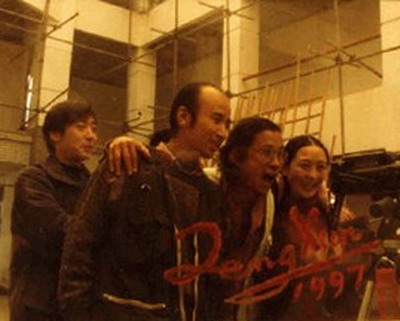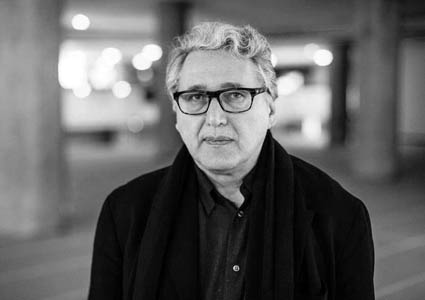
高氏兄弟《临界·大十字架——福音书》,装置,高300cm,1994-96
首先,中国先锋艺术思想史是一种语言史。在七种世界的生成因子中,语言具有当然的优先性。“人类最初听到的、亲眼看到的、亲手摸到的一切都是活生生的语言;因为神就是词语。语言以他口中和心中的词为发端,就像孩子的游戏一样自然、真实、简单”。[1]当艺术爱者面对一幅油画、一件装置、一张图片、一段录像的时候,他“首先”面临的是它们作为不同的艺术语言(或曰作品的能指)如何传递作者的艺术观念(或曰作品的所指)的问题,即艺术家表达得怎样的难题;他首先看到的是油画的色彩与构成、装置的摆放与结构、图片的角度与曝光、录像的截屏与切换之类艺术语言要素。这里,我们已经涉及到艺术语言的两个核心概念即媒材与媒介。不用说,丙烯、油彩、帆布属于媒材的范畴,但油画却属于一种古老的艺术媒介;同样,如在梁绍基的作品中,蚕茧、铁屑、人体等等属于艺术的媒材,但蚕丝艺术却属于一种崭新的媒介的创造。当我们说中国先锋艺术思想史是一种语言史的时候,其意思是要阐明中国先锋艺术作品中个别艺术家如何使用媒材的过程,阐明整体的艺术界如何推进媒介的演变历程。前者意味着要发现艺术家作为个体生命的原初艺术语言图式,后者意味着要评论艺术界作为知识生产群体的媒介更新的现状。

曾循Zeng Xun《神框系列“Magic Frame series”》,行为,1997

朵夫《权力与音乐的默契》,综合绘画,油彩,绳子,480x160cm,1992
在整体上,中国的先锋艺术家大部分都是在延续一种或几种艺术媒介内展开局部的媒材更新实验,如装置艺术中高氏兄弟对于文革史料灰烬、红卫兵袖章等材料的挪用(《临界·大十字架》,1994-96),毛同强使用纸本地契、木质镜框(《地契》,2009);大地艺术中戴光郁把国画宣纸置换为冰雪、挪用水墨这种国画媒材(《风水·墨水·冰水》系列,200412-200502);油画媒介中王波以线装书页为油画底色(《重现的风景》系列,2008-至今)。这些作品的关注点在媒材更新的可能性上。至于行为中刘成英、曾循对于装置元素的借鉴(《邮政慢件》,1997;曾循:《神框系列》,1997),影像中马良使用摄影图片(《白色上的白色》,2010),艾萨克·朱利安(Isaac Julien)的多屏影像装置(《万重浪(Ten Thousand Waves)》,2010)等等。后三者属于两种艺术媒介或跨媒介创作。其实,更早把装置与绘画融合起来的范例,还有朵夫围绕抽象绘画语言探索的作品《权力与音乐的默契》(1992)。它“使用了一些材料,如用截断的长短不一的麻绳细密排列成一个特定形态,麻绳的质感凸显了画面的深度,并且打破画面单一视觉维度,将视觉审美进行延伸。这在一定程度上去除了传统抽象绘画意义范畴内的二维性错觉。朵夫在画布上试验的材料拼贴手法,预示艺术家正在向艺术构成的现成品过度,如麻绳、铁链以及砍骨头的刀等,同时画面色彩的处理是用喷枪喷上去的,喷枪取代画笔,朵夫已经走向艺术语言观念上的扩张。”(文中子语)朵夫第二年创作的综合绘画《绳子》依然带有装置的元素。“他不像早期现代主义那样追求以物质材料的组合为审美目的的‘拼贴’效果,也不像目前在国内一些搞材料的青年艺术家那样以视觉性为材料运用的目的,即创造出绘画所不具有的视觉效果。他以材料本身作为主题意义的载体,从而超越了材料的视觉性。如绳子系列就是以绳本身作为追求的对象,直接进入历史与现实的主题。”(易英语)正因为如此,艺术评论家刘晓纯看后却认为他脱离传统绘画元素太快而完全走向了材料和装置。以此反观最近几年盛行的油画家以油画为媒介去表达国画的花鸟之类题材,或者制作油画作品的雕塑版之类现象,或者国画家用影像录制创作国画的过程,其实与真正的跨媒介创作毫无关系。因为,它们甚至没有推进如油画、雕塑、影像之类作为单个艺术媒介语言的实质更新,更不用说对多个媒介语言的实验探究。真正的跨媒介创作,在创作过程中要求艺术家不仅对于单一媒介有高度娴熟的技能,而且有综合把握不同媒介的能力,将它们有机地融合在一起。换言之,中国当代艺术界尽管呈现出一种以媒介为中心的语言观,但艺术家最缺乏的是单个艺术媒介的创新能力,以及综合使用多种媒介的能力。其根本原因,或许在于艺术家的人文学养的穷困。
至于艺术界的跨界现象,如画家去拍摄电影或电影导演来创作影像艺术,或者艺术家在自己创作中综合使用不同学科的知识,这最终还是要回到艺术家对于单一或多种媒介本身的把握上。就笔者所见而言,到目前为止,中国的先锋艺术中并没有留下值得从思想史层面来讨论的作品。有的艺术家离开自己熟悉的媒介而进入另外的媒介领域,在艺术表达上立即就显得非常幼稚。他们虽然相信不同的艺术媒介之间有着共同性,但没有对于自己陌生的媒介的独特性的发展的历史之把握,没有对于其中的经典作品的内在研究,没有对于它们的差别性的洞见,根本就不可能深度理解它们之共同性。这就是我们在一些油画家的作品展览上只会看到关于它们的雕塑版、影像版或装置版的原因。
History of Ideas for the Cutting-edge in Contemporary Chinese Art as a History of Language
Text/Nishimi Masao Translation by Lance Pursey
An idea first worth discussing is history of ideas for the cutting-edge in contemporary Chinese art as a kind of history of language. Previously we already touched upon 7 factors (including things such as language, time, the individual, the natural world, society, history and even God) that make up a person’s world, of them language has an obvious precedence. As Walter Benjamin said, "Everything that man heard in the beginning, saw with his eyes, and felt with his hands was the living word; for God was the word. With this word in his mouth and in his heart, the origin of language was as natural, as close, and as easy as a child's game ... "[2]
When art lovers come upon a work, be it an oil painting, an installation, a photograph, or a video, the first thing they really interface with is the artistic language ( or signifier) of this particular medium. They inquire how this language conveys or can potentially convey the artist’s particular artistic ideas ( or signifié), and the deeper and more difficult question of judging how successful the artist has been in getting across this intended message. The first thing the audience may see is the basics of artistic language, which for oil painting would be the colours and structure, for installation art the set up and lay out, for photography the angle and exposure and for video art the shot and editing of the recording. Here, we have already hit on two central concepts in the language of art, namely, materials and media. While it goes without saying, acrylics, oils and canvas all count as materials, oil paint also serves as a medium, and a very ancient medium at that. The divide between materials and media is often blurred, as is demonstrated in some of Liang Shaoji’s works, which include what we would consider the materials, such as silk cocoons, iron filings, the human body, however while silk is a material it can also serve as a relatively new medium for artistic creation.
When we talk about the contemporary Chinese art’s history of ideas as a history of language we mean to draw attention to the processes in which cutting-edge artists use materials, we also do so to expose how the art world as a whole collectively advances the diversification of available artistic media. The former intention implies that we need to map out the original artistic language of the artist as an individual, while the latter goal encourages us to view the current state of the art world as a knowledge producing collective that establishes new forms of media.
On the whole, most Chinese cutting-edge artists continue new experimentation with different materials within the umbrella of one or several already established forms of artistic media. Examples of this can be seen in installation art with the Gao Brothers working with artefacts from the Great Cultural Revolution such as the ashes of historical records, red guard armbands and so on, (“Crisis: the Big Crucifix,1994-96), Mao Tongqiang’s use of paper land contracts and wooden spectacle frames (“Land Contract”,2009); in land art we have Dai Guangyu, rather than paint on the xuan paper of traditional Chinese painting, instead painted inks on snow (“Feng Shui-Ink-Frozen Water” series, 2004.12 – 2005.02), while in the medium of oil painting Wang Bo once incorporated the colour of thread bound book paper as the primer for his works (“Reappearing Landscape” series, 2008 – now). The appeal of these works is in the new possibilities for using materials that they offer. There are also examples of this in performance art, like Liu Chengying and Zeng Xun’s adaptation of elements of installation (“Snail Mail”, 1997, “Magic Frame series”, 1997), and in video, where artists such as Ma Liang used still photographic images (“White on White”, 2010), and Isaac Julien employed multi-screen video installations (“Ten Thousand Waves”, 2010).
The last three are examples of multimedia or transmedia works, works that employ or span several different media. In fact there are earlier instances of the combination of installation and painting, for example Duo Fu’s “The Tacit Agreement of Power and Music” (1992), a work that features explorations into the language of abstract painting. In the words of Wen Zhongzi, he “uses some materials, like different pieces of rope, which he has cut to different lengths and arranged in a specific pattern. The texture of these pieces of rope creates a sense of depth to the image, giving it an extra dimension in both the visual and the aesthetic sense.”
The following year Duofu produced the piece entitled “Rope” which again incorporated elements of installation. At the time Yi Ying commented, “He is not like the early modernists who would use different materials to achieve a sort of ‘collage’ aesthetic, nor does he resemble many young artists currently working in mainland China who use materials to try and create visual images and effects that paintings would be unable to produce. Rather he uses the materials themselves as the vehicle to convey the thematic meaning of his work, and in doing so he goes beyond the visual dimension of the materials he uses. His work with rope is precisely work about exploring the possibilities and connotations of rope itself, and in this way he directly touches on themes in history and reality.”
But for other critics this was exactly the problem of the piece. After seeing the work, art critic Liu Xiaochun commented that the artist had cast off elements of more traditional painting far too quickly, and had completely moved into materials and installation. With this in mind when we look back over some of the art from the last few years, we see experiments such as oil painters using oils as a medium to paint traditional Chinese bird and flower paintings, or using oil paintings to form some kind of sculpture, or even traditional Chinese painters using video to make their work. In truth, however, these efforts don’t have much to do with the language of transmedia art. They haven’t even contributed to the further enrichment of the artistic language of oils, sculpture or video as individual media, let alone explored and experimented with the language of multimedia and transmedia art. Real transmedia work requires artists to have a high level of proficiency not only in the individual media he is using, but also a grasp of using different media together, to enable these media to blend together organically. In other words, although the contemporary Chinese art world eschews a language that acknowledges the primacy of media, what Chinese artists lack more than anything else is the ability to innovate in any single individual medium, and in the ability to synthesise from several different media effectively.
As for evaluating the ‘cross-over’ phenomenon in the world of art, such as painters shooting films or film directors making video art, or artists incorporating knowledge from different academic disciplines into their work, at the end of the day we have to go back to the artist’s grasp of individual and multi - media. Speaking from my personal experience, from what I have seen so far, Chinese avant-garde has yet to produce work worthy of discussing from the perspective of the history of ideas. Some artists in departing from their familiar medium and entering into another field or medium immediately appear, from the standpoint of artistic expression, incredibly immature. They may well believe there is common ground between different artistic media, but if they have not recognised the historical development that has brought about the idiosyncrasies of the unfamiliar medium the artist wishes to explore, nor researched and investigated the classic works within the medium, nor gained deep insight into the subtle differences between certain works, it is impossible for them to fully comprehend the depth of the similarities between two media. This is why when we attend some exhibitions of oil painters we only hear about the artists’ forays into sculpture or video or installation (checked by Zha Changping).
--------------------------------------------------------------------------------
[1] 瓦尔特·本雅明:“论语言本身和人的语言”(1916),《本雅明文选》,陈永国 马海良编,北京:中国社会科学出版社,1999年,第273页。
[2]Benjamin, Walter, “On Language as such and on the Language of Man” in Selected Writings Volume 1 1913-1926.
扩展阅读
艺术档案 > 评论档案 > 中国先锋艺术思想史:作为语言史
view.php?tid=8988&cid=1
艺术档案 > 大史记 > 艺术思潮 > 国内 > 中国先锋艺术思想史:作为时间史
view.php?tid=8669&cid=42
艺术档案 > 大史记 > 艺术思潮 > 国内 > 查常平:中国先锋艺术思想史引论
view.php?tid=8670&cid=42
【声明】以上内容只代表原作者个人观点,不代表artda.cn艺术档案网的价值判断。

